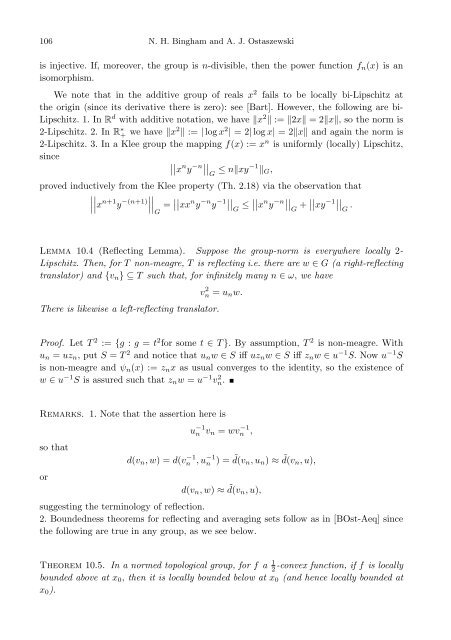Normed versus topological groups: Dichotomy and duality
Normed versus topological groups: Dichotomy and duality
Normed versus topological groups: Dichotomy and duality
You also want an ePaper? Increase the reach of your titles
YUMPU automatically turns print PDFs into web optimized ePapers that Google loves.
106 N. H. Bingham <strong>and</strong> A. J. Ostaszewskiis injective. If, moreover, the group is n-divisible, then the power function f n (x) is anisomorphism.We note that in the additive group of reals x 2 fails to be locally bi-Lipschitz atthe origin (since its derivative there is zero): see [Bart]. However, the following are bi-Lipschitz. 1. In R d with additive notation, we have ‖x 2 ‖ := ‖2x‖ = 2‖x‖, so the norm is2-Lipschitz. 2. In R ∗ + we have ‖x 2 ‖ := | log x 2 | = 2| log x| = 2‖x‖ <strong>and</strong> again the norm is2-Lipschitz. 3. In a Klee group the mapping f(x) := x n is uniformly (locally) Lipschitz,since∣ ∣ ∣x n y −n∣ ∣ ∣ G≤ n‖xy −1 ‖ G ,proved inductively from the Klee property (Th. 2.18) via the observation that∣∣ ∣∣∣x n+1 y −(n+1) ∣∣ ∣∣G= ∣ ∣ xx n y −n y −1∣ ∣ ∣ G≤ ∣ ∣ x n y −n∣ ∣ ∣ G+ ∣ ∣ ∣ xy−1 ∣ G.Lemma 10.4 (Reflecting Lemma). Suppose the group-norm is everywhere locally 2-Lipschitz. Then, for T non-meagre, T is reflecting i.e. there are w ∈ G (a right-reflectingtranslator) <strong>and</strong> {v n } ⊆ T such that, for infinitely many n ∈ ω, we haveThere is likewise a left-reflecting translator.v 2 n = u n w.Proof. Let T 2 := {g : g = t 2 for some t ∈ T }. By assumption, T 2 is non-meagre. Withu n = uz n , put S = T 2 <strong>and</strong> notice that u n w ∈ S iff uz n w ∈ S iff z n w ∈ u −1 S. Now u −1 Sis non-meagre <strong>and</strong> ψ n (x) := z n x as usual converges to the identity, so the existence ofw ∈ u −1 S is assured such that z n w = u −1 v 2 n.Remarks. 1. Note that the assertion here isso thatord(v n , w) = d(v −1nu −1n v n = wvn −1 ,, u −1n ) = ˜d(v n , u n ) ≈ ˜d(v n , u),d(v n , w) ≈ ˜d(v n , u),suggesting the terminology of reflection.2. Boundedness theorems for reflecting <strong>and</strong> averaging sets follow as in [BOst-Aeq] sincethe following are true in any group, as we see below.Theorem 10.5. In a normed <strong>topological</strong> group, for f a 1 2-convex function, if f is locallybounded above at x 0 , then it is locally bounded below at x 0 (<strong>and</strong> hence locally bounded atx 0 ).
















